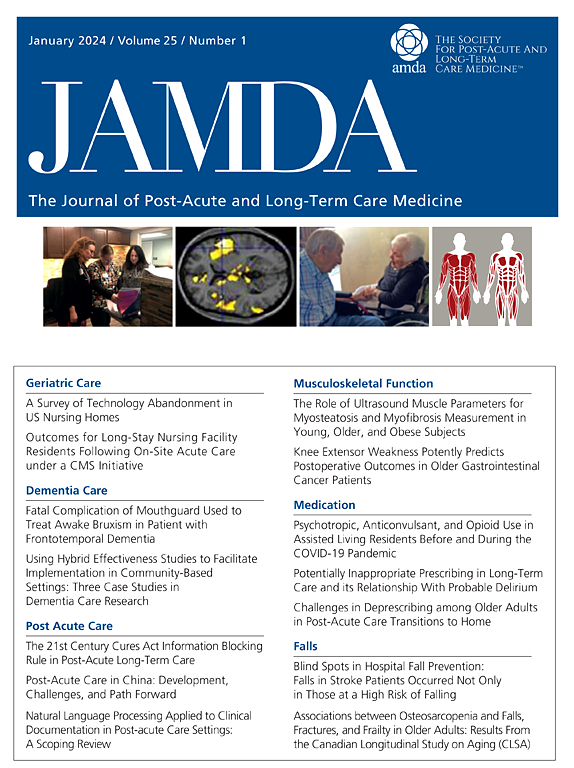Factors Influencing Initial Rehabilitation Type after Hip Fracture Surgery: A Retrospective Cohort Study
IF 4.2
2区 医学
Q2 GERIATRICS & GERONTOLOGY
Journal of the American Medical Directors Association
Pub Date : 2025-03-19
DOI:10.1016/j.jamda.2025.105521
引用次数: 0
Abstract
Objective
To describe and compare the factors that impact initial rehabilitation type after hip fracture surgery.
Design
Retrospective population-based cohort study.
Setting and Participants
People aged between 50 and 105 with a hip fracture who had a surgical repair in Ontario, Canada, between January 1, 2015, and December 31, 2021.
Methods
Descriptive statistics and a multinomial logistic regression model were used to identify factors associated with initial rehabilitation type.
Results
In this study, 63,401 individuals were included with a mean age of 80 years [standard deviation (SD) 10.9], mostly female (67.3%), with 86.3% living in urban areas at the time of hospitalization and most (72.6%) admitted from the community without home care. A total of 24.5% of individuals did not receive any form of rehabilitation. Rurality of residence decreased the odds of having an initial rehabilitation type in complex continuing care [odds ratio (OR), 0.23; 95% CI, 0.21–0.26], in inpatient rehabilitation (OR, 0.26; 95% CI, 0.24–0.28), or in community rehabilitation (OR, 0.54; 95% CI, 0.50–0.58) compared with no rehabilitation. Dementia decreased the odds of having an initial rehabilitation type in complex continuing care (OR, 0.75; 95% CI, 0.69–0.81), in inpatient rehabilitation (OR, 0.44; 95% CI, 0.41–0.47), or in community rehabilitation (OR, 0.88; 95% CI, 0.82–0.95) compared with receiving no rehabilitation. Previous history of fragility fracture decreased the odds of having an initial rehabilitation type in either complex continuing care (OR, 0.30; 95% CI, 0.27–0.34), in inpatient rehabilitation (OR, 0.27; 95% CI, 0.24–0.29), or in community rehabilitation (OR, 0.33; 95% CI, 0.30–0.37) compared with no rehabilitation.
Conclusions and Implications
Rurality of residence, dementia, and previous history of fragility fractures reduced the odds of receiving specialized inpatient rehabilitation and increased the odds of receiving no rehabilitation. Future research should focus on achieving more equitable care for individuals living in rural settings, with dementia, or with previous fragility fractures to enhance the quality of care and achieve best outcomes for the overall hip fracture population.
影响髋部骨折术后初始康复类型的因素:回顾性队列研究
目的描述并比较影响髋部骨折术后初始康复类型的因素:设计:基于人群的回顾性队列研究:年龄在 50 岁至 105 岁之间、在 2015 年 1 月 1 日至 2021 年 12 月 31 日期间在加拿大安大略省接受过手术修复的髋部骨折患者:方法:采用描述性统计和多项式逻辑回归模型来确定与初始康复类型相关的因素:本研究共纳入 63401 名患者,平均年龄为 80 岁(标准差 [SD] 10.9),大部分为女性(67.3%),86.3% 的患者在住院时居住在城市地区,大部分(72.6%)患者从社区入院,没有家庭护理。共有 24.5% 的患者没有接受任何形式的康复治疗。与未接受康复治疗相比,居住地偏远会降低最初接受复合持续护理康复治疗(几率比 [OR],0.23;95% CI,0.21-0.26)、住院康复治疗(OR,0.26;95% CI,0.24-0.28)或社区康复治疗(OR,0.54;95% CI,0.50-0.58)的几率。与不接受康复治疗相比,痴呆症降低了接受复杂持续护理(OR,0.75;95% CI,0.69-0.81)、住院康复(OR,0.44;95% CI,0.41-0.47)或社区康复(OR,0.88;95% CI,0.82-0.95)的初始康复类型的几率。与未接受康复治疗相比,曾有脆性骨折史的患者接受复合持续护理(OR,0.30;95% CI,0.27-0.34)、住院康复(OR,0.27;95% CI,0.24-0.29)或社区康复(OR,0.33;95% CI,0.30-0.37)的初始康复类型的几率降低:结论:居住地偏远、痴呆症和既往脆性骨折病史降低了接受住院专业康复治疗的几率,增加了不接受康复治疗的几率。未来的研究应侧重于为居住在农村地区、患有痴呆症或曾发生过脆性骨折的患者提供更公平的护理,以提高护理质量,为整个髋部骨折人群实现最佳治疗效果。
本文章由计算机程序翻译,如有差异,请以英文原文为准。
求助全文
约1分钟内获得全文
求助全文
来源期刊
CiteScore
11.10
自引率
6.60%
发文量
472
审稿时长
44 days
期刊介绍:
JAMDA, the official journal of AMDA - The Society for Post-Acute and Long-Term Care Medicine, is a leading peer-reviewed publication that offers practical information and research geared towards healthcare professionals in the post-acute and long-term care fields. It is also a valuable resource for policy-makers, organizational leaders, educators, and advocates.
The journal provides essential information for various healthcare professionals such as medical directors, attending physicians, nurses, consultant pharmacists, geriatric psychiatrists, nurse practitioners, physician assistants, physical and occupational therapists, social workers, and others involved in providing, overseeing, and promoting quality

 求助内容:
求助内容: 应助结果提醒方式:
应助结果提醒方式:


